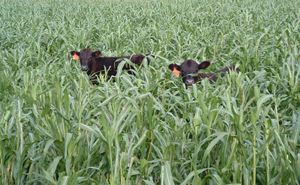ARS Study Shows No Damage To Soils From Grazing Of Cover Crops
BELTSVILLE, MD.
A U.S. Department of Agriculture (USDA) scientist in North Carolina has found a way to encourage more growers to use cover crops in the Southeastern United States – allow cattle to graze on them.
Cover crops reduce soil erosion, boost organic matter, keep more moisture in soil and sequester carbon in the soil so less of it is released as a greenhouse gas.
Conventional wisdom holds that if cattle were allowed to graze on cover crops they would eat up and remove the nitrogen and carbon otherwise left on the soil in the cover crop plant residue. Allowing cattle to tread on the soil also could compact it, preventing air and water from passing through the soil to reach plant roots.

Contrary to conventional wisdom, grazing low numbers of cattle on cover crops does not compact the soil or cut down on the organic matter added, according to new ARS research.
ARS Photo
Alan Franzluebbers, an ecologist with the Agricultural Research Service (ARS) Plant Science Research Unit in Raleigh, conducted a 7-year study to see if grazing on cover crops affects the health of soils typical in the Piedmont region. ARS is USDA’s principal intramural scientific research agency, and this research supports the USDA priority of promoting sustainable agriculture.
Franzluebbers and his colleagues grew winter or summer grains and used cover crops for both in the off-season. They also compared no-till versus tilling, and grazing versus no grazing. Cow/calf pairs were allowed to graze at a rate of one pair per 4 acres.
The researchers took periodic samples of the surface foot of soil. The study was the first in the region to analyze the practices for such an extensive period.
The results showed that the relatively low-level of grazing did not significantly affect the amount of organic matter in soil and did not compact the soil. They also showed that cover crops provided high quality forage and that the organic matter lost by allowing cattle to graze on cover crops was likely made up in the organic material supplied as manure. As in previous studies, they also found that no-till soils generally contained more carbon and nitrogen than conventional till soils. ∆